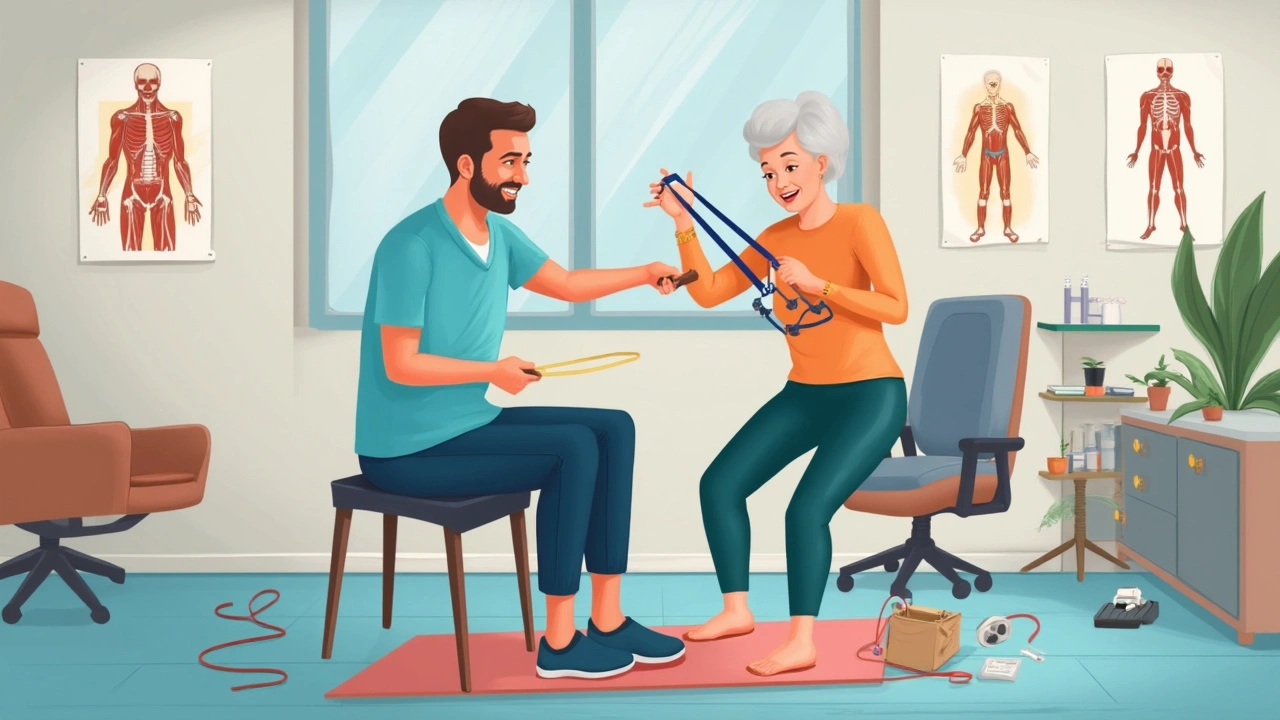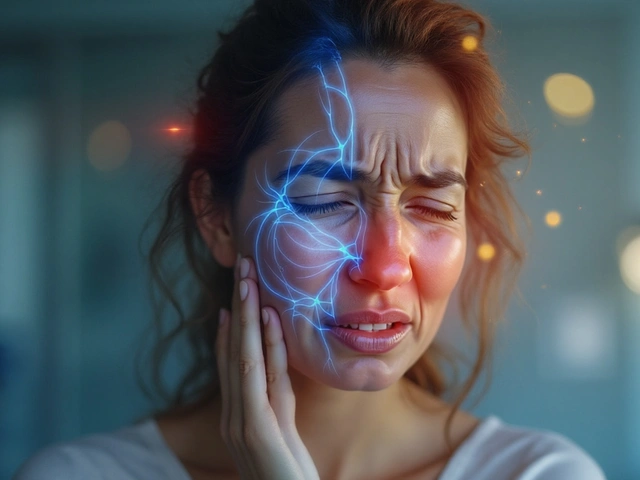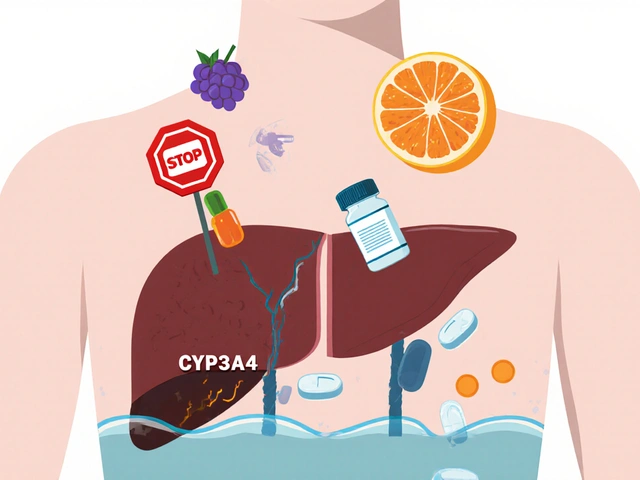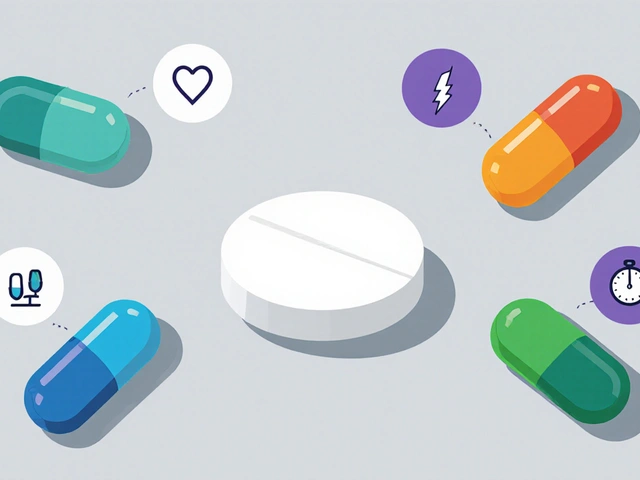Pain can steal your sleep, wreck your mood, and mess with your focus. So it's no wonder a lot of people turn to hydrocodone for relief. But let’s be real: opioids like hydrocodone come with baggage—long-term risks, side effects, and, yeah, the constant worry about dependence. The good news? There are legit alternatives.
Some work better for certain types of pain or fit specific lifestyles. Others take some patience, but they don’t come with the heavy risks you get from opioids. Want to manage pain without being handcuffed to pills? Let’s get into the nuts and bolts of the best options—and how they stack up in real life.
- Physical Therapy (Massage, Acupuncture, Heat/Cold Therapy)
- NSAIDs and Non-Opioid Medications
- Cognitive Behavioral Therapy (CBT) and Mind-Body Approaches
- Medical Cannabis and CBD
- Topical Analgesics
- Summary and Comparison Table
Physical Therapy (Massage, Acupuncture, Heat/Cold Therapy)
Let’s talk about pain relief that doesn’t involve popping pills. Physical therapy covers a range of hands-on and hands-off options to fight pain without the mess of hydrocodone alternatives like opioids.
Massage isn’t just a spa thing. Regular sessions can loosen tight muscles, improve blood flow, and help push out that awful ache you get after injuries, back pain, or those long hours at a desk. Trigger-point massage targets knots deep inside—think of it as getting the kink worked out of a twisted garden hose. Swedish and deep tissue are also popular, each focusing on certain types of soreness or tension. Real-life bonus: Less soreness usually means better sleep and more movement.
Acupuncture is another big player here. It isn’t magic—it’s science-backed. Tiny needles placed into the skin prompt your body to release endorphins and tweak the way pain messages fly up to your brain. The American Pain Society and the National Institutes of Health both recognize acupuncture for things like low back pain and osteoarthritis. It’s especially handy for nerve issues or chronic pain that just won’t let up.
Then you’ve got heat and cold therapy, which almost everyone’s tried at some point. Ice packs lower swelling and numb intense pain, like after a pulled muscle. Heating pads or warm baths relax stiff joints and muscles. Here’s a tip: Go with cold for sudden injuries and swelling, and use heat for ongoing aches or tension. Don’t mix it up, or you might make things worse instead of better.
So why choose these physical approaches? Plenty of people want a real break from pain management medication side effects—like drowsiness, constipation, and the whole dependency risk. Plus, when you treat pain physically, you support healing, not just numb it out.
Pros
- No drug-related side effects, so you avoid issues like nausea or grogginess.
- Promotes healing by boosting blood flow and supporting the body’s repair process.
- Can pair with other pain relief methods for a holistic approach that fits real life.
- Reduces reliance on opioid alternatives or prescription meds.
- Pretty low risk when done by trained pros—no scripts needed.
Cons
- You’ve gotta stick with regular appointments to see results—not a quick fix.
- Time-consuming if you’re juggling work, kids, or tons of daily stuff.
- Not cheap if your health insurance doesn’t cover it.
- Effectiveness depends on your specific pain—sometimes muscle, joint, or nerve pain responds better than constant, widespread pain.
| Physical Therapy Type | Pain Relief Success Rate | Good For |
|---|---|---|
| Massage | 60-75% | Muscle pain, stress, tension |
| Acupuncture | 50-70% | Chronic pain, nerve pain |
| Heat/Cold Therapy | Varies, up to 80% for acute injury | Acute injury, swelling, stiffness |
If you want real, lasting pain improvement and fewer hassles than medication, trying out a physical solution could be a smart move. Don’t expect miracles overnight, but with some patience, you might just find yourself reaching for the ice pack or booking a massage instead of that refill.
NSAIDs and Non-Opioid Medications
If you’ve ever reached for ibuprofen (Advil) or naproxen (Aleve) after a sprain or headache, you’re already familiar with NSAIDs. These meds are anti-inflammatories, and they’re real workhorses for all sorts of pain—from backaches to arthritis and even dental pain.
Unlike opioids like hydrocodone, NSAIDs target pain by taming inflammation. They don’t give you that sedated feeling, and you won’t run into the risk of dependency. That’s a huge plus for folks worried about getting hooked.
Here’s a quick look at popular NSAIDs and non-opioid options used for pain:
- Ibuprofen (Advil, Motrin): Common for headaches, muscle pain, and minor injuries.
- Naproxen (Aleve): Great for joint pain and longer-lasting relief—one pill can keep you covered for up to 12 hours.
- Aspirin: Classic choice, but not for everyone—especially if you have stomach ulcers or take blood thinners.
- Acetaminophen (Tylenol): Not technically an NSAID, but a solid option for pain and fever without the stomach irritation.
Sometimes doctors combine meds for better effect, like acetaminophen with caffeine or in specific migraine meds. These combos tackle pain from multiple angles, and you don’t need a heavy-duty opioid.
Pros
- No opioid-related dependency or high risk of addiction.
- Easy to get—most are over-the-counter in pharmacies and supermarkets.
- Work quickly for mild to moderate pain.
- Can reduce swelling from injuries or joint pain (NSAIDs only).
Cons
- Can cause stomach irritation or ulcers with long-term use.
- Not great for people with kidney, liver, or heart problems.
- Don’t always knock out severe pain (like after major surgery).
- Can raise blood pressure if used regularly.
| Medication | Type | Duration | Over-the-counter? |
|---|---|---|---|
| Ibuprofen | NSAID | 4–6 hours | Yes |
| Naproxen | NSAID | 8–12 hours | Yes |
| Aspirin | NSAID | 4–6 hours | Yes |
| Acetaminophen | Non-NSAID | 4–6 hours | Yes |
If your pain is chronic or severe, always check with a doctor before popping NSAIDs every day. These meds can be super helpful for daily aches and pains—just don’t ignore the warnings if you’ve got medical conditions that can get in the way.
Cognitive Behavioral Therapy (CBT) and Mind-Body Approaches
If you’re serious about ditching hydrocodone alternatives for something low-risk, CBT and mind-body methods are big players. They work on changing how you think about pain, not just masking it. No, it’s not about “pretending the pain isn’t there”—it’s about proven mental hacks that actually turn down your body’s pain signals. Talk about getting your brain to cooperate with your body for a change.
CBT is all about breaking the cycle: pain, worry, more pain, and so on. It usually happens with a licensed therapist and you don’t need to spill your guts—this is super practical stuff. Techniques might include tracking your triggers, stress-busting routines, or setting solid goals for your day so your brain isn’t hyper-focused on hurting all the time.
Other mind-body tricks aren’t magic either. Meditation, deep breathing, and even guided imagery have real science behind them. For example, mindfulness meditation for chronic pain patients has been shown to reduce the brain’s pain response in several cool MRI studies. And, if you stick with them (no, you don’t have to meditate for hours), you can get relief without any pills at all.
Here’s what a typical CBT pain management plan might look like:
- Weekly sessions (in-person or online) with a trained therapist
- Journaling your pain triggers and daily activities
- Learning relaxation and distraction tactics
- Building realistic activity goals
- Practicing deep breathing or guided meditation a few minutes daily
Want a sense of the numbers? Clinical trials report that around 60% of chronic pain patients using CBT see moderate to major improvement in both pain level and coping skills. The big win isn’t just feeling less pain—it’s needing fewer meds like hydrocodone.
| Therapy | Average Pain Score Reduction | Reduction in Medication Use |
|---|---|---|
| CBT | 25-45% | 30-40% |
| Standard Medication Only | 10-20% | N/A |
These mind-body approaches won’t make you pain-free overnight, but they’re a solid, science-backed path that helps people manage pain—and life—a lot better than just popping pills and hoping for the best.
Pros
- No drug side effects
- Builds long-term coping skills
- Can reduce the need for pain relief meds
- Improves mood and sleep
- Easily paired with other treatments
Cons
- Progress can be slow—takes weeks to months
- Requires motivation and regular effort
- Not usually covered 100% by insurance
- Won’t work for every single pain condition

Medical Cannabis and CBD
Heard about folks trading hydrocodone alternatives for something more "green"? Medical cannabis and CBD are getting a lot of attention as pain management tools. We're not talking about getting stoned—these options are about real, practical relief for people who want to manage things like nerve pain, arthritis, or even chronic back pain.
Medical cannabis refers to the whole plant, often prescribed or recommended for severe, long-lasting pain. CBD (cannabidiol) is one compound from the cannabis plant that doesn't get you high—it's available in oils, capsules, and even gummies. Both can help lower pain for plenty of conditions when you need to avoid opioids or want a backup plan.
In states and countries where it’s legal, doctors actually write scripts for medical cannabis to help folks get off or lower their use of opioids like hydrocodone. That alone says something about trust within the medical community. And get this: a study published in JAMA in 2022 showed chronic pain patients using medical cannabis dropped their prescription opioid use by up to 44%.
CBD, in particular, is often the "gateway" for people wanting to ease pain with fewer side effects. You won’t get a buzz from it, which makes it a safe starting point for many. Some folks rub CBD cream right onto sore spots, use patches, or take drops under the tongue. It’s being studied for joint pain, migraines, nerve pain, and even some types of muscle spasms.
Pros
- Less risk of addiction than traditional opioids like hydrocodone
- Often fewer side effects; CBD doesn’t cause drowsiness or stomach upset for most people
- May help with pain that doesn’t fade with ordinary painkillers (think nerve or inflammatory pain)
- Medical cannabis may also help improve sleep and reduce anxiety, which can fuel pain issues
Cons
- Medical marijuana isn’t legal everywhere—always check local laws
- Can cause psychoactive effects (the "high"), especially with THC-heavy strains
- Long-term effects of medical cannabis and CBD still need more research, especially with daily use
- Quality control can be an issue if you’re buying from unregulated sellers
If you’re eyeing hydrocodone alternatives and thinking about cannabis or CBD, talk to a doctor who knows the ropes. Don’t just snatch something off the shelf at a gas station—medical advice is key to getting the dose and product right for your pain type.
| Type | Common Uses | Legal Status (US) | Main Drawback |
|---|---|---|---|
| Medical Cannabis | Severe or chronic pain, neuropathy, cancer pain | Legal in over 35 states | Psychoactive effects |
| CBD Oil | Arthritis, muscle/joint pain, anxiety-related pain | Legal federally (if THC < 0.3%) | Quality and dose inconsistencies |
Topical Analgesics
If swallowing pain pills isn’t your thing, topical analgesics might be your new best friend. These creams, gels, and patches target pain at the source—meaning you put them right where it hurts. No more waiting around for a pill to kick in.
These products work by delivering pain-relieving or anti-inflammatory ingredients directly through your skin. You’ll see names like lidocaine (numbs the area), menthol and camphor (they have a cooling effect), or capsaicin (the stuff that gives chili peppers their kick). They can help with joint pain, muscle aches, back pain, and even nerve pain, depending on the brand and ingredient.
People like topical analgesics because you can keep using your hands, shoulders, or knees without zoning out from a pill. Most brands are available over the counter. Some need a prescription for higher strengths, especially if you want strong lidocaine patches (often 5%). That OTC stuff found at any drugstore—think Icy Hot, Salonpas, or Aspercreme—can do the trick for mild or moderate pain. If you're dealing with arthritis or fibromyalgia, these creams might not erase the pain, but they might take the sharpness down a notch.
Here's something cool: There’s less risk of stomach issues compared to NSAIDs, and you don’t get the fogginess or dependency worries like you do with hydrocodone. That’s a huge plus, especially for people who want to avoid opioids. But don’t expect miracles; these work best for localized pain and often need to be applied several times a day.
Pros
- Targeted relief right where you hurt—no need to affect your whole body
- Most formulas are available without a prescription
- Little to no risk of opioid dependency or drowsiness
- Safe to combine with physical therapy or non-opioid medications
Cons
- Doesn’t always work on deep or severe pain
- Needs repeated applications, which can be a hassle
- Some people get skin irritation or dislike the smell
- If you have pets or small kids, you have to be extra careful—some ingredients can be harmful if swallowed or transferred
| Ingredient | How it Works | Common Brands |
|---|---|---|
| Lidocaine | Numbs nerve endings | Aspercreme, Lidoderm |
| Menthol/Camphor | Creates cooling sensation to distract from pain | Icy Hot, Biofreeze |
| Capsaicin | Reduces pain signals over time | Capzasin-HP, Zostrix |
If you’re not keen on opioids but still want relief you can actually feel, topical analgesics are worth a shot. Try a few to see which works for your type of pain. Just keep the tube out of reach from curious kids and pets—you don’t want capsaicin fingers in your eyes, trust me.
Summary and Comparison Table
If you want to stop using hydrocodone alternatives and pick something that actually works, a side-by-side comparison helps a lot. Each option comes with its ups and downs. Non-opioid meds work for some but not all pains. Physical therapy needs commitment but has fewer side effects. Medical cannabis isn’t legal everywhere and doesn’t suit everyone, but a lot of people use it for nerve or chronic pain. Topical creams are easy to use but mainly help surface pain. CBT? It’s all about retraining your brain’s reaction to pain—takes time, but the benefits add up.
Here’s a simple look at how these pain relief options stack up:
| Alternative | What It’s Good For | Pros | Cons |
|---|---|---|---|
| Physical Therapy (Massage, Acupuncture, Heat/Cold Therapy) | Chronic pain, muscle and joint pain, tension, recovery | No meds needed, less risk, boost healing, whole-body benefits | Time-consuming, can cost money, works best with consistency |
| NSAIDs & Non-Opioid Meds | Short-term pain, inflammation, everyday aches | Easy to find, proven, no addiction risk | Stomach issues, risky for long-term use, not for every type of pain |
| Cognitive Behavioral Therapy (CBT) and Mind-Body Approaches | Chronic pain, tension headaches, stress-related issues | No side effects, builds coping skills, long-term payoff | Needs time and effort, sometimes not covered by insurance |
| Medical Cannabis & CBD | Nerve pain, chronic pain, sleep problems | Some folks swear by it, non-opioid, relaxing | Legal issues, doesn’t work for everyone, can cause drowsiness |
| Topical Analgesics | Surface pain, arthritis, sore spots | Direct relief, easy to use, no pills | Mainly helps mild-to-moderate pain, can irritate skin |
Still not sure what’s the right fit? Try tracking which methods help you most every week. Pain relief is really personal. What works for your neighbor or even your brother might fall flat for you. If you’re serious about ditching hydrocodone, bring up these hydrocodone alternatives at your next doctor’s visit. Ask which combos could line up best with your pain type and lifestyle. Mixing two or three could be the ticket—like physical therapy with a non-opioid med on bad days. Just remember, there’s no single best answer. It’s all about finding your own sweet spot where pain doesn’t call the shots.







Julia C
July 18, 2025 AT 14:00Honestly, I was hoping for a more revolutionary take here, but the article pretty much sticks to the usual suspects: physical therapy, holistic stuff, yada yada. Don't get me wrong, I get the idea of avoiding opioids like hydrocodone due to addiction and side effects, but if these alternatives were so effective, why is pain management still such a nightmare?
They do mention pros and cons which is fine, but I wish there was more hard data or user experience involved rather than just theoretical benefits. Also, the phrase "you can actually use" seems a bit patronizing; people suffering from chronic pain aren’t exactly lazy or clueless. If anyone’s tried these alternatives and actually found relief, spill the tea. It feels like the article is dancing around the truth that sometimes, nothing beats strong meds for serious pain.
And while we're on the topic, what about the whole conspiracy of pushing meds over holistic care for profit reasons? Would’ve loved to see the article tackle that head-on instead of tiptoeing around the topic.
John Blas
July 18, 2025 AT 14:08I second that. It's an uphill battle trying to find something that works as well as hydrocodone, especially when the pain is relentless. Physical therapy and alternative treatments are great in theory, but can they truly replace the ease of popping a pill that numbs the pain almost instantly?
Also, the stigma around opioid use makes it harder to get the help you actually need. It's like you have to prove your pain is 'real' to even get hydrocodone, yet alternatives are shoved down your throat as some miracle cure. I wonder if the article really gives us anything practical or if it's just more fluff.
Feeling a bit skeptical about this one, honestly.
Lexi Benson
July 18, 2025 AT 14:58Wow, you guys sound borderline cynical about this topic! While I get that opioids like hydrocodone are effective, they're also a slippery slope for many.
Physical therapy and holistic treatments won't magically erase severe pain overnight, but they can be part of a sustainable lifestyle change that doesn't put you at risk of addiction or nasty side effects. The article’s tone is refreshingly balanced, highlighting both pros and cons, which is way more helpful than pushy pharma ads or fear-mongering about opioids.
@333, about the conspiracy stuff — it's a valid concern, but throwing around conspiracy theories without evidence does more harm than good. Instead, focusing on verified, practical options is more productive.
Anyway, if anyone’s got experiences integrating these alternatives successfully, I’m all ears.
Vera REA
July 18, 2025 AT 16:00Just chiming in from a more laid-back point of view. This dilemma between opioids and alternatives isn't new, but it's good to see a discussion that doesn't demonize one side or the other. Pain management is so personal and varied.
I appreciate the article taking a look at real-life practicality, because it’s easy to glorify natural therapies, but not everyone has the luxury or time to commit to intense physical therapy regimens.
Sometimes, people just need immediate relief to function, even if it means taking hydrocodone for a while. The key, I think, is knowing when and how to use these alternatives in combination to optimize outcomes without over-dependence.
Curious if anybody has tried combining holistic approaches with pain meds and what worked best?
Vikas Kale
July 18, 2025 AT 16:46From a pharmacological and clinical perspective, balancing nociceptive and neuropathic pain management using multimodal analgesia is the gold standard. Hydrocodone, an opioid agonist primarily acting on mu-opioid receptors, offers robust relief but carries addiction risks and respiratory depression.
Alternatives like physical therapy address biomechanical etiologies while holistic modalities might modulate central sensitization via psychoneuroimmunology pathways. However, their efficacy varies widely, influenced by patient compliance, psychosocial factors, and the underlying pathology.
One must consider evidence-based integrative modalities in treating complex cases, such as combining cognitive-behavioral therapy, acupuncture, and transcutaneous electrical nerve stimulation (TENS) alongside judicious opioid use. The article touches on these but could delve deeper into the neurobiological mechanisms and clinical trial data.
Dan Burbank
July 18, 2025 AT 16:13Well, I've seen countless patients and people I've known get trapped in the opioid cycle, and honestly, hydrocodone is overrated for chronic pain. It's not a magic bullet; the side effects are brutal, and the risk of addiction should not be understated. This article's focus on alternatives like physical therapy and holistic treatments is exactly what needs to happen. People need to consider the root causes and incorporate methods that might not provide immediate relief but promote long-term wellness.
That said, not all holistic options are created equal. Some practices border on snake oil, and you need to be discerning. Still, I appreciate that this breakdown is practical, avoiding the hyperbole that floods so many health articles nowadays. The real truth about non-opioid options is that they demand patience and consistency, and they certainly deserve more respect than they get in mainstream medicine.
Overall, props for pushing the conversation forward but remember, sometimes alternative isn't synonymous with effective for everyone. Individual pain management is complex, no one-size-fits-all solution.
Anna Marie
July 22, 2025 AT 03:53I truly appreciate this post because living with pain is challenging, and finding alternatives to hydrocodone often feels overwhelming. Physical therapies have helped a lot of my friends regain mobility and manage their pain better without the risk of dependency. The article’s emphasis on realistic options speaks volumes to people who need actionable advice rather than empty promises.
Holistic treatments can be beneficial, but it’s crucial that individuals consult healthcare professionals before ditching prescribed medications entirely. Everyone’s pain experience is unique, and a balance between traditional and alternative methods could be more effective. It’s comforting to see that the article doesn’t dismiss hydrocodone outright but explores what else could supplement or replace it thoughtfully.
Does anyone have personal experience combining both approaches that they can share here?
Abdulraheem yahya
July 26, 2025 AT 03:53This is actually a topic that deserves more spotlight globally. In many parts of the world, access to opioids like hydrocodone is limited, yet pain relief remains a universal necessity. It's inspiring to see discussions focused on practical, non-opioid methods, which can be more sustainable and accessible in the long run. I've noticed that educating patients on the benefits and realistic outcomes of practices like acupuncture, physiotherapy, and mindfulness has helped change their outlook on pain management.
However, integration of these methods into standard care isn't always straightforward. Insurance coverage, cultural acceptance, and clinician awareness can all be barriers. So while alternatives exist and work, widespread adoption needs systemic changes. Still, the more people understand the pros and cons as this article outlines, the better we can advocate for varied pain management strategies that suit different lifestyles and levels of pain.
Preeti Sharma
July 29, 2025 AT 11:06Honestly, while I see the appeal in alternatives, I think the pendulum sometimes swings too far away from opioids, almost ignoring their place entirely. Pain is multi-dimensional, right? For some people, hydrocodone or similar medications might genuinely be the only thing that works. The philosophical question is -- what is the purpose of pain relief? Is it to erase pain, or to coexist with it wisely through different strategies?
Non-opioid methods are valuable, but dismissing hydrocodone as some evil remnant simply ignores the nuanced realities of human suffering. This article presents options, yet the narrative has to include that medicine is both an art and a science; a single solution doesn't fit all.
Ted G
August 2, 2025 AT 00:00Look, I don’t buy this article’s neat packaging of alternatives without factoring in the pharmaceutical industry’s influence on what treatments get spotlighted or suppressed. Hydrocodone? Sure, it’s got problems, but what about the hidden agendas behind pushing 'holistic' options? I bet some of these 'real truths' are just smoke screens to funnel money into trendy therapies that don’t necessarily deliver.
Are we forgetting that sometimes, the so-called natural or physical therapies have their own risks and side effects? Are they really better, or just better marketed? I remain skeptical until there’s hard evidence that these alternatives provide consistent and measurable relief across a wide patient base.
Miriam Bresticker
August 5, 2025 AT 11:35omg this article tho 👏👏 honestly i love the vibe of focusing on what works outside the usual opioid convo ❤️👍 like ppl rlly need more options that dont mess with their heads or bodies so much. i feel like holistic stuff can be super powerful if u give it some time and patience 🌿✨
also, physical therapy is such a underrated hero here!!! not just cuz it’s science but cuz it actually gets ur body moving better and less painful over time <3
btw does anyone else have fave non-drug pain relief methods?? 🥰
Claire Willett
August 8, 2025 AT 21:06Really interesting piece. The pragmatic approach to alternatives to hydrocodone is what the field needs. Physical therapies, for instance, are well-documented for improving functionality and reducing reliance on opioids. The article’s balanced presentation of pros and cons elevates the discourse, avoiding the simplistic 'opioids bad, alternatives good' narrative prevalent in many discussions.
Further investment in evidence-based holistic interventions could alleviate the burden on healthcare systems. Encouraging multidisciplinary collaboration is crucial — for instance, physios, psychologists, and primary care providers working together to tailor pain strategies. This synergy ensures that pain relief is not merely symptomatic but addresses underlying contributors.
Keli Richards
August 12, 2025 AT 09:33Thanks for this post, really helpful. Pain management can often feel isolating, especially when you’re tired of just popping pills. Physical therapy has been a godsend for my mom, she’s managed to lessen reliance on hydrocodone quite a bit through consistent exercises and some alternative therapies.
That said, it definitely requires commitment and realistic expectations—there’s no magic cure.
I also found that combining mental health support helped her cope with the emotional toll of chronic pain. The article’s candid approach about pros and cons encourages people not to give up and to explore multiple avenues. Has anyone else noticed better outcomes when combining mind and body treatments for pain?
Ravikumar Padala
August 15, 2025 AT 00:53Honestly, I’m skeptical about how much alternatives can replace hydrocodone for severe pain. The article sounds hopeful, but in practice, the relief from physical therapies or holistic treatments isn't always enough. For some, these are supplementary at best, not substitutes.
Plus, the variability in patient responses makes it tricky to recommend universally. We need more rigorous studies and long-term data before jumping ship on opioids entirely. I respect the intent, but the reality is often more complicated than it seems on paper.
King Shayne I
August 16, 2025 AT 05:30This article's approach is flat-out naive if it ignores the darker side of opioid withdrawal and how dangerous it can be for those who get off hydrocodone without professional guidance. Alternatives might 'work' for some, but the transition needs medical supervision. Otherwise, you're risking more harm.
Also, I doubt holistic therapies can replace the potency of opioids in all cases. Pain is subjective, but it can be incapacitating. Suggesting non-opioid options as a one-stop solution is, to me, irresponsible without emphasizing the complexity and the need for individualized plans crafted by experts.
jennifer jackson
August 17, 2025 AT 15:23Love seeing this conversation happen! Pain relief is super personal, and alternatives to hydrocodone deserve attention. I've found gentle yoga and mindfulness meditation to be really effective along with physical therapy. They don’t replace meds entirely for me but definitely cut down my reliance and improve my overall wellbeing.
It’s all about finding what resonates with your body and mind. The pros and cons outlined help set knee-jerk reactions aside and encourage thoughtful experimentation. Big fan of bridging traditional and alternative practices, honestly.
Does anyone have success stories with specific holistic therapies? Would love to hear more!